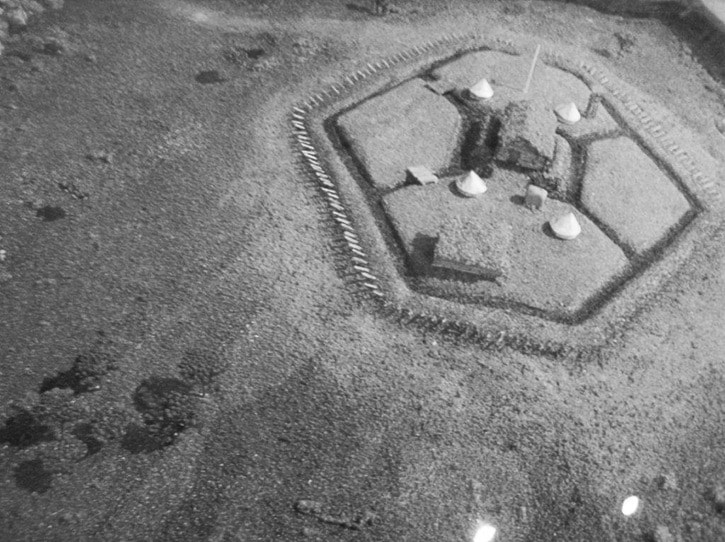The first settlers in this area would trade their furs and obtain their vital supplies year round from the Hudson’s Bay Company trading post located on the north bank of the Battle River. On April 11, 1885 this busy HBC post was pillaged by a roving band of Cree Indians during a tense and violent time of the ongoing Riel Rebellion across the prairies. After an immediate order from Fort Edmonton, the commander of the Alberta Field Force fortified several strategic points in the Battle River district by dispatching Captain John Benjamin Ostell and Lieutenant Leander Plinquet and 20 members of the 65th Mounted Royal Rifles to the troubled Hudson’s Bay Trading Post.
In the meantime, several battalions of mounted troops were seen on the Calgary to Edmonton trail on their way to Fort Edmonton to be dispatched into hot spots of the uprising, and would stop at the Battle River Crossing on April 28, 1885. The locals were thrilled to see this first line of the law show their force, including the scarlet clad men of the North West Mounted Police and the Nile green uniforms of the 65th Battalion.
On May 10, 1885, the company led by Captain Ostell arrived and began to establish a fortress for the protection of those at the Hudson’s Bay Trading Post, including Reverend M.P. Scollen’s house, as well as the many travellers passing through the area on the new Calgary/Edmonton trail. These hardy French Canadian soldiers, who were paid 50 cents a day, began their work immediately, first digging a trench two-and-a-half-foot deep around the HB store and about 200 feet in diameter around all the buildings. Then a moat five-foot deep was dug around the house and connected to the outer trench by means of four canals. The walls of the trading post were strengthened with additional timbers and 28 loopholes were cut between the logs to allow the men to fire at an invading enemy with relative safety. The building itself was partitioned into two sections, one for the officers quarters and the other for a kitchen and dormitory, then to further fortify the area, earth from the original trench was piled in the form of a regular embankment and then an abbittis consisting of sharpened branches was formed on the banks. Strong barricades were also constructed to protect the doors and the windows of the post, while a six-foot-high turf wall was built all around the house above the moat.
A log stable was located within the compound and the only method of bringing horses and supplies to or from the building was across the two canals, both of which were spanned by movable bridges. Four bell tents were also erected within the barricade, one guard tent, a soldier’s tent, the captain’s tent, and a baker’s tent, and also at the rear of the fort was an open oven, while the flagpole was raised in front of the sentry box. This magnificent structure of that early colorful era was completed in only a few weeks, and was named Fort Ostell in honour of Captain John B. Ostell, the Commander of the Royal Rifles. During the period of the construction the 65th Battalion had many visitors, including a steady stream of stages coaches, wagon trains and other travellers on the busy C/E Trail, as well as two more military groups heading for the big fight in Saskatchewan. After the post was well fortified and blessed by Monsignor Grandin, Captain Ostell established friendly relations with the Stonies of Sharphead’s Band, whom he respected and could depend on, and attempted to procure arms for them to help keep the Bear Hills quiet and to keep the vital road from Edmonton to Battle River open and interrupted. Just how successful the quick and very solid fortifications at Fort Ostell would have been during an actual attack cannot be surmised, as the post was never engaged in a battle with the roving Cree bands, who watched the work of the soldiers very closely, but probably soon realized that any attempt to overpower the fortress was likely impossible.
By June 27, 1885, Batoche had fallen, Louis Riel had been captured, and peace finally returned to the prairies, whose rapidly growing population of settler families would now vigorously get on with building their new homes, farms, and communities, as well as looking forward to a long and successful future in the fertile new land. Thus the life of Fort Ostell as a military post was only about 50 days, from May 9 until June 27, after which Captain Ostell and his troop returned to Fort Edmonton to receive new orders, and then later joined their comrades to carry on their duties of protecting the rugged prairies.
Although no visible remains of the historic wood and earth fortress can be seen to this day, the location of historical Fort Ostell would have been located in the farm field just south of the county dump site at the south end of Ponoka. The legal land description for the site of that first Hudson’s Bay Company Post is S.W. 5-43-25-W4th, and an historical marker has been placed at the corner of 42nd Avenue and 66th Street in honour of this most important and exciting chapter of our early history 130 long years ago. This grand and thrilling old Fort Ostell tale has and will always be preserved in our town and county with the long-time prescense of the Fort Ostell Library, the Fort Ostell Chapter of the Imperial Order Daughter of the Empire, and the Fort Ostell Museum in the Ponoka Lion’s Centennial Park, which has a very special corner dedicated to its exciting name sake.
